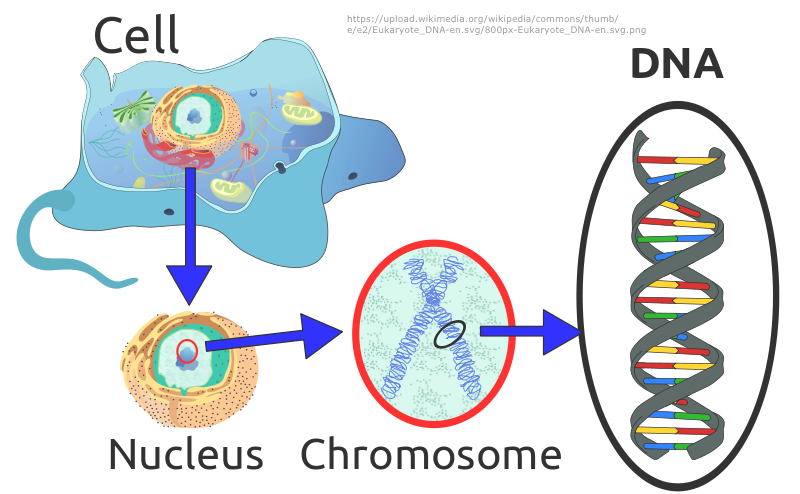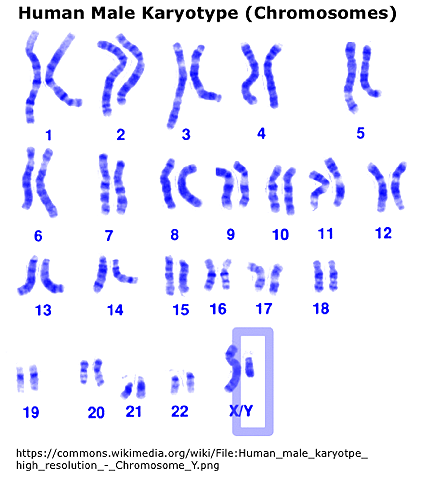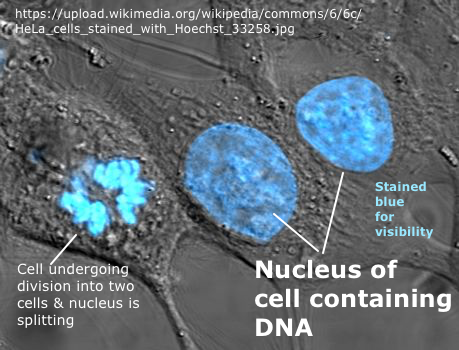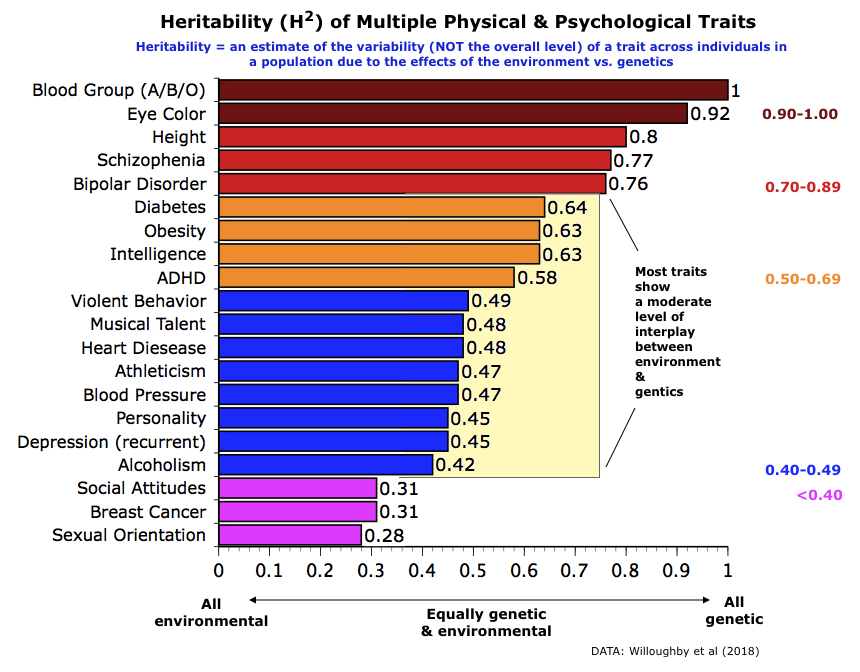Class 17: Some Notes on Heredity and Evolutionary Psychology
Heredity & Behavior
|
Basic Principles
of Genetics

 Chromosomes = strands of DNA
(deoxyribonucleic acid) molecules that carry genetic
information.
Chromosomes = strands of DNA
(deoxyribonucleic acid) molecules that carry genetic
information.Genes = segments of DNA that serve as the key functional unit in hereditary transmission. Each gene contains the blueprint or template for the production of a protein.
Human beings have 23 pairs of chromosomes: 22 pairs plus for men an X & Y chromosome and for women two X chromosomes.

![[Generic
Family Relatedness]](../psy101graphics/Genetic_Family_Relatedness.png) Research
Strategies
Research
Strategies
1. Family studies: Examine blood relatives to see how much they resemble one another on a trait
2. Twin studies: Monozygotic (identical) twins [share 100% of same genes] vs. dizygotic (fraternal) twins [share ca. 50% of same genes] (see chart on right)
3. Adoption studies: adopted children compared to adoptive parents vs. birth parents
Example:
Schizophrenic
(SCZ)
Disorders (see chart on right)
Note: A concordance rate means the odds (expressed as a percentage) that, if one member of a population has a factor/disorder/trait, another member will have that factor/disorder/trait
- Random pair in general population ≤ 1% concordance rate
- First cousins = 2% concordance rate
- Siblings = 9% concordance rate
- Identical twins = 40-50% concordance rate
Why is this evidence that SCZ cannot be merely an hereditary disorder, that is, that SCZ is not due solely to genetic influences?
4. Genetic Mapping (= Genome Wide Association Studies, GWAS)
- In the years since 2010 the cost of completing a complete sequencing or map of an individual's genome (all the genes belonging to a particular individual) has dropped dramatically (e.g., from $2.7 billion in the 1990s --> $100 million in 2001 --> $10 million in 2007 --> $10,000 in 2011 --> about $1,000 today).
- As a result, scientists now study issues like the genetic causes of mental disorder, cognitive abilities, etc. by studying many thousands of individuals. Such research is called a "Genome Wide Association Study" or GWAS.
- The original expectation for GWASs was that scientists would identify a handful of genes associated with different mental conditions, e.g., a couple of genes causing schizophrenia, bipolar disorder, overall intelligence level, etc.
- Some individual
genes were found to be associated with specific disorders,
e.g, cystic fibrosis, Huntington's disease, forms of
muscular dystrophy.
- HOWEVER, the
results of GWASs show that the heritability of most behavioral
traits and mental conditions results
from the small effects of dozens, hundreds, or even
thousands of individual genes as they have an interactive
effect, i.e., polygenetic determinism (see below).
- For example, GWASs indicate that there are over 100 different gene variants that are associated with the development of SCZ where each variant contributes a small amount the vulnerability (see below) to develop this disorder.
- In another study
of over 1.1 million genomes, researchers found that
educational attainment was moderately heritable. They
detected 1,721 different gene variants associated with
educational attainment.
The Interplay
of Heredity & Environment
1. Traits associated with genes are usually not associated with just a single gene but with a network, group, or set of multiple genes = polygenetic determinism
Single Gene Disorders
Multiple Gene/Polygenetic Disorders
cystic fibrosis
alpha- and beta- thalassemias (less hemoglobin than normal)
sickle cell anemia (sickle cell disease)
Marfan syndrome (connective tissue disorder)
fragile X syndrome
Huntington's disease
hemochromatosis (too much iron stored)
heart disease
high blood pressure
Alzheimer's disease
arthritis
diabetes
cancer
obesity
2. We tend not to inherit a disorder genetically, but a genetic vulnerability to or disposition for disorder (this vulnerabilty is called a "diathesis" in medicine) which must be triggered or induced by experiences within the environment. Thus, diathesis + high environmental stress = disorder. At the end of the semester we will look at some of the environmental triggers associated with SCZ.
- For example, children born in families with high levels of depressive illness are at increased risk for depression themselves. This is likely due, at least at some level, to a genetic vulnerability. However, various traumatic experiences in life might be needed to trigger the depression, e.g,. loss of a parent at a very young age or being the object of ridicule by peers, etc.
3. Epigenetics = study of heritable changes in how genes express themselves that do NOT involve modifications to the DNA sequence. Recent findings show that certain environmental effects such as high stress or various chemicals in the environment can lead to the silencing of genes or reducing how well they can cause things to happen (in biology, often resulting from a process called DNA methylation) without actually eliminating or changing the genes themselves. Some of these changes can be passed on to the next generation.
4. Most traits are the result of the combined effects of heredity and environment (see chart below):

The Evolutionary Basis of Behavior
|
Some of these questions may sound like something to be argued on Oprah. But, they are some of the kinds of questions which are often suggested by aspects of the relatively new theory of evolutionary psychology.
Charles Darwin's Theory (1859: On the Origin of Species by Means of Natural Selection)
- Various physical characteristics or traits emerge due to random genetic changes. These traits can be passed down to subsequent generations. He didn't know the actual mechanism of genes (i.e., chromosomes with DNA), but knew there was some physical mechanism involved in how living creatures develop.
- Fitness: a characteristic which makes an organism more likely to have reproductive success (that is, have offspring) compared to the average member of a population. BY THE WAY, Darwin did not talk about the "survival of the fittest" but believed in the survival of the "more fit".
- Natural selection: the process by which hereditary characteristics tend to survive or be passed on (that is, "selected" out or "chosen" by nature) because such characteristics make the organism either
- More likely to survive to have offspring and pass the characteristic to a new generation, or
- More likely to attract a mate so that offspring result and the characteristic is passed to a new generation
Modern Refinements = Evolutionary Psychology
![[Darwin's On the Origin of Species]](../psy101graphics/darwin_origins.jpg)